爱思唯尔新版投稿系统(EVISE)论文状态详解
Elsevier投稿各种状态总结
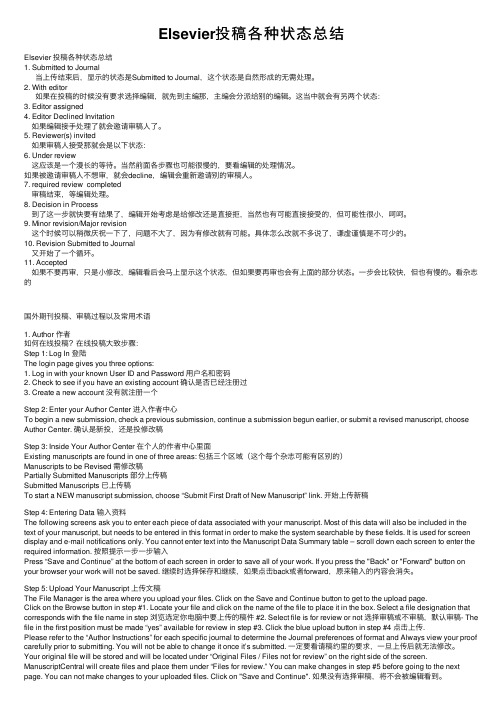
Elsevier投稿各种状态总结Elsevier 投稿各种状态总结1. Submitted to Journal当上传结束后,显⽰的状态是Submitted to Journal,这个状态是⾃然形成的⽆需处理。
2. With editor如果在投稿的时候没有要求选择编辑,就先到主编那,主编会分派给别的编辑。
这当中就会有另两个状态:3. Editor assigned4. Editor Declined Invitation如果编辑接⼿处理了就会邀请审稿⼈了。
5. Reviewer(s) invited如果审稿⼈接受那就会是以下状态:6. Under review这应该是⼀个漫长的等待。
当然前⾯各步骤也可能很慢的,要看编辑的处理情况。
如果被邀请审稿⼈不想审,就会decline,编辑会重新邀请别的审稿⼈。
7. required review completed审稿结束,等编辑处理。
8. Decision in Process到了这⼀步就快要有结果了,编辑开始考虑是给修改还是直接拒,当然也有可能直接接受的,但可能性很⼩,呵呵。
9. Minor revision/Major revision这个时候可以稍微庆祝⼀下了,问题不⼤了,因为有修改就有可能。
具体怎么改就不多说了,谦虚谨慎是不可少的。
10. Revision Submitted to Journal⼜开始了⼀个循环。
11. Accepted如果不要再审,只是⼩修改,编辑看后会马上显⽰这个状态,但如果要再审也会有上⾯的部分状态。
⼀步会⽐较快,但也有慢的。
看杂志的国外期刊投稿、审稿过程以及常⽤术语1. Author 作者如何在线投稿?在线投稿⼤致步骤:Step 1: Log In 登陆The login page gives you three options:1. Log in with your known User ID and Password ⽤户名和密码2. Check to see if you have an existing account 确认是否已经注册过3. Create a new account 没有就注册⼀个Step 2: Enter your Author Center 进⼊作者中⼼To begin a new submission, check a previous submission, continue a submission begun earlier, or submit a revised manuscript, choose Author Center. 确认是新投,还是投修改稿Step 3: Inside Your Author Center 在个⼈的作者中⼼⾥⾯Existing manuscripts are found in one of three areas: 包括三个区域(这个每个杂志可能有区别的)Manuscripts to be Revised 需修改稿Partially Submitted Manuscripts 部分上传稿Submitted Manuscripts 已上传稿To start a NEW manuscript submission, choose “Submit First Draft of New Manuscript” link. 开始上传新稿Step 4: Entering Data 输⼊资料The following screens ask you to enter each piece of data associated with your manuscript. Most of this data will also be included in the text of your manuscript, but needs to be entered in this format in order to make the system searchable by these fields. It is used for screen display and e-mail notifications only. You cannot enter text into the Manuscript Data Summary table – scroll down each screen to enter the required information. 按照提⽰⼀步⼀步输⼊Press “Save and Continue” at the bottom of each screen in order to save all of your work. If you press the "Back" or "Forward" button on your browser your work will not be saved. 继续时选择保存和继续,如果点击back或者forward,原来输⼊的内容会消失。
Elsevier期刊投稿状态
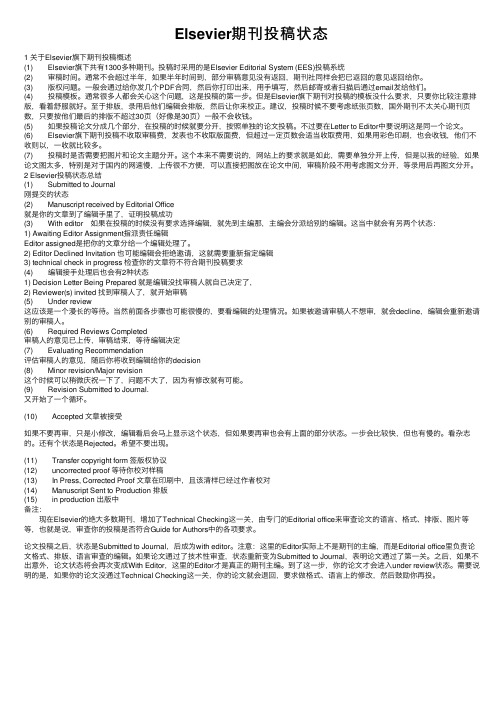
Elsevier期刊投稿状态1 关于Elsevier旗下期刊投稿概述(1) Elsevier旗下共有1300多种期刊。
投稿时采⽤的是Elsevier Editorial System (EES)投稿系统(2) 审稿时间。
通常不会超过半年,如果半年时间到,部分审稿意见没有返回,期刊社同样会把已返回的意见返回给你。
(3) 版权问题。
⼀般会通过给你发⼏个PDF合同,然后你打印出来,⽤⼿填写,然后邮寄或者扫描后通过email发给他们。
(4) 投稿模板。
通常很多⼈都会关⼼这个问题,这是投稿的第⼀步。
但是Elsevier旗下期刊对投稿的模板没什么要求,只要你⽐较注意排版,看着舒服就好。
⾄于排版,录⽤后他们编辑会排版,然后让你来校正。
建议,投稿时候不要考虑纸张页数,国外期刊不太关⼼期刊页数,只要按他们最后的排版不超过30页(好像是30页)⼀般不会收钱。
(5) 如果投稿论⽂分成⼏个部分,在投稿的时候就要分开,按照单独的论⽂投稿。
不过要在Letter to Editor中要说明这是同⼀个论⽂。
(6) Elsevier旗下期刊投稿不收取审稿费,发表也不收取版⾯费,但超过⼀定页数会适当收取费⽤,如果⽤彩⾊印刷,也会收钱,他们不收则以,⼀收就⽐较多。
(7) 投稿时是否需要把图⽚和论⽂主题分开。
这个本来不需要说的,⽹站上的要求就是如此,需要单独分开上传,但是以我的经验,如果论⽂图太多,特别是对于国内的⽹速慢,上传很不⽅便,可以直接把图放在论⽂中间,审稿阶段不⽤考虑图⽂分开,等录⽤后再图⽂分开。
2 Elsevier投稿状态总结(1) Submitted to Journal刚提交的状态(2) Manuscript received by Editorial Office就是你的⽂章到了编辑⼿⾥了,证明投稿成功(3) With editor 如果在投稿的时候没有要求选择编辑,就先到主编那,主编会分派给别的编辑。
这当中就会有另两个状态:1) Awaiting Editor Assignment指派责任编辑Editor assigned是把你的⽂章分给⼀个编辑处理了。
Elsevier期刊投稿和投稿经验
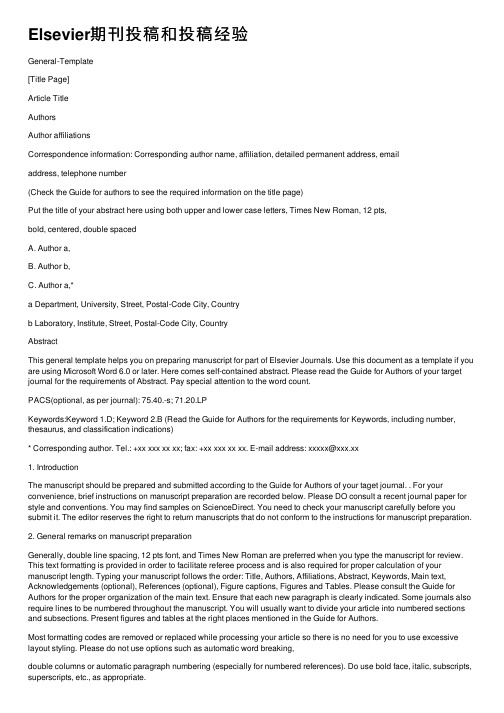
Elsevier期刊投稿和投稿经验General-Template[Title Page]Article TitleAuthorsAuthor affiliationsCorrespondence information: Corresponding author name, affiliation, detailed permanent address, emailaddress, telephone number(Check the Guide for authors to see the required information on the title page)Put the title of your abstract here using both upper and lower case letters, Times New Roman, 12 pts,bold, centered, double spacedA. Author a,B. Author b,C. Author a,*a Department, University, Street, Postal-Code City, Countryb Laboratory, Institute, Street, Postal-Code City, CountryAbstractThis general template helps you on preparing manuscript for part of Elsevier Journals. Use this document as a template if you are using Microsoft Word 6.0 or later. Here comes self-contained abstract. Please read the Guide for Authors of your target journal for the requirements of Abstract. Pay special attention to the word count.PACS(optional, as per journal): 75.40.-s; 71.20.LPKeywords:Keyword 1.D; Keyword 2.B (Read the Guide for Authors for the requirements for Keywords, including number, thesaurus, and classification indications)* Corresponding author. Tel.: +xx xxx xx xx; fax: +xx xxx xx xx. E-mail address: xxxxx@xxx.xx1. IntroductionThe manuscript should be prepared and submitted according to the Guide for Authors of your taget journal. . For your convenience, brief instructions on manuscript preparation are recorded below. Please DO consult a recent journal paper for style and conventions. You may find samples on ScienceDirect. You need to check your manuscript carefully before you submit it. The editor reserves the right to return manuscripts that do not conform to the instructions for manuscript preparation.2. General remarks on manuscript preparationGenerally, double line spacing, 12 pts font, and Times New Roman are preferred when you type the manuscript for review. This text formatting is provided in order to facilitate referee process and is also required for proper calculation of your manuscript length. Typing your manuscript follows the order: Title, Authors, Affiliations, Abstract, Keywords, Main text, Acknowledgements (optional), References (optional), Figure captions, Figures and Tables. Please consult the Guide for Authors for the proper organization of the main text. Ensure that each new paragraph is clearly indicated. Some journals also require lines to be numbered throughout the manuscript. You will usually want to divide your article into numbered sections and subsections. Present figures and tables at the right places mentioned in the Guide for Authors.Most formatting codes are removed or replaced while processing your article so there is no need for you to use excessive layout styling. Please do not use options such as automatic word breaking,double columns or automatic paragraph numbering (especially for numbered references). Do use bold face, italic, subscripts, superscripts, etc., as appropriate.2.1 IllustrationsMany journals required that figures and tables to be presented on separate pages at the end of the manuscript. The preferable file formats are: EPS (for vector graphics) and TIF (for bitmaps). However, PDF and MS Office (Word, Excel, Powerpoint figures) files are also acceptable. Use file names that enable to identify their contents in terms of figure number and format (e.g. fig1.tif, fig2.eps, fig3.pdf). All artwork has to be numbered according to its sequence in the text. All of them should have captions. Colour figures in printed version require an extra fee for most journals. Generally, no vertical rules (lines) should be used in tables. Illustrations should not duplicate descriptions that appear elsewhere in the manuscript.Please look at /doc/7b0fa158d1d233d4b14e852458fb770bf68a3b3a.html/wps/find/authors.authors/authorartworkinstructions for more detailed instructions on artwork preparations.2.2 EquationsConventionally, in mathematical equations variables and anything thatrepresents a value appear in italics. You are encouraged to use equation-editing tools such as mathtype to edit equations. Please make use of the numbering and referencing functions.2.3 CitationsThere are different styles of in-text citations and reference lists. DO consult the Guide for Authors to see the given examples. Pay special attention to the format of author names, journal names, publication year, volume and page span. AcknowledgementsThis section is optional.References[1].[2].Figure CaptionsFig.1 Put at this page the collected figure captions. The figure captions should be as brief as possible. It should also contain sufficient information that readers do not need to refer to the main text.Fig.2 Put here the figure caption of figure 2 (also the legend to figure 2).Fig. 3Fig. 1. Sample figure. Do not reduce or enlarge any images after placement in an MS Office application as this can lead to loss of image quality. While inserting vector graphics ensure that you use only truetype fonts. These should preferably be in one, or a combination, of the following fonts: Arial, Courier, Helvetica, Symbol, Times.Table 1Sample table: (使⽤三线表)Parameter Compound 1 Compound 2 a(?) 4.5832 4.9365Δ E a (eV) 1.745 1.592 ………………a This is an example of a table footnote.关于Elsevier旗下期刊投稿1 关于Elsevier旗下期刊投稿概述(1) Elsevier旗下共有1300多种期刊。
爱思唯尔投稿指南课件
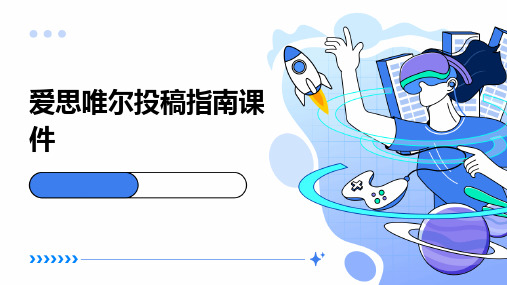
爱思唯尔尊重作者的署名权和作品的完整性,对稿件进行必要的编辑和修 改会事先征求作者意见。
05
与编辑沟通
回复编辑意见
01
仔细阅读编辑的意见和建议,理解其意图和要求。
02
针对每条意见,给出具体的回应和解释,表明自己 的观点和改进措施。
论文在线出版
提交最终稿件
作者需要在规定的时间内,提交最终的稿件到爱思唯尔在线平台。
稿件审核与排版
爱思唯尔会对稿件进行审核和排版,以确保符合出版要求。
论文推广和引用
论文推广
爱思唯尔会通过其官方网站、社交媒体 等渠道,对已发表的论文进行推广,以 提高论文的知名度和影响力。
VS
引用管理
爱思唯尔提供引用管理服务,帮助作者管 理论文引用信息,并生成正确的引用格式 。
爱思唯尔投稿指南课 件
目录
CONTENTS
• 爱思唯尔期刊概览 • 投稿流程 • 稿件要求 • 作者指南 • 与编辑沟通 • 发表和推广
01
爱思唯尔期刊概览
期刊种类
综合性期刊
涵盖多个学科领域的期刊,适合发表跨学科 的研究成果。
专业性期刊
专注于某一学科或领域,发表特定研究方向 的论文。
开放获取期刊
03
避免与编辑产生不必要的争执和冲突,保持友好和 专业的态度。
稿件修订
01 根据编辑的意见和建议,对稿件进行全面检查和 修订。
02 着重修改文章的结构、逻辑、语言表达等方面的 问题,提高文章的质量和可读性。
03 注意保持原意,避免过度修改或改变作者的本意 。
重新提交稿件
01
在完成修订后,将稿件重新提交给编辑进行审核。
Elseriver 系统EES 投稿系统格式及操作流程指南
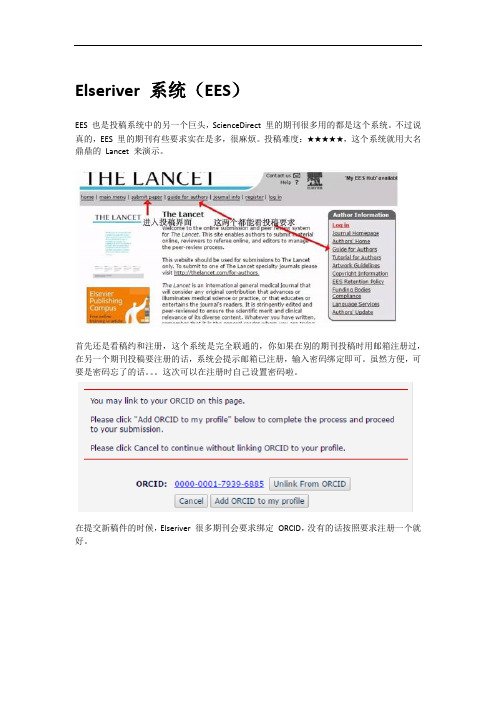
Elseriver 系统(EES)
EES 也是投稿系统中的另一个巨头,ScienceDirect 里的期刊很多用的都是这个系统。
不过说真的,EES 里的期刊有些要求实在是多,很麻烦。
投稿难度:★★★★★,这个系统就用大名鼎鼎的Lancet 来演示。
首先还是看稿约和注册,这个系统是完全联通的,你如果在别的期刊投稿时用邮箱注册过,在另一个期刊投稿要注册的话,系统会提示邮箱已注册,输入密码绑定即可。
虽然方便,可要是密码忘了的话。
这次可以在注册时自己设置密码啦。
在提交新稿件的时候,Elseriver 很多期刊会要求绑定ORCID,没有的话按照要求注册一个就好。
看上去和Editorial 差不多,可就是这个标红的Additional Information,能够做的及其恶心人,而且在Editorial 里出现的概率并不高,可在Elseriver 里就变的十分常见,一般回答Yes,No,None 就可以了,或者就是要试验注册号或者伦理号的
上传文件的地方,有这么多项,与Editorial 还有点不同的是,Elseriver 只支持单个文件上传,而且每换个项目都要刷新网页,如果网络不好的话,很费时间。
上传完文件后就和Editorial 大同小异了,确认pdf,完成。
爱思唯尔审稿状态under review

爱思唯尔审稿状态under review爱思唯尔(Elsevier)作为世界著名的学术出版机构,承载着无数学者的科研成果和学术成就。
而对于大部分学者来说,向爱思唯尔投稿并通过审稿是一件至关重要的事情,因为这意味着他们的研究成果将被全球学术界广泛认可和引用。
而在这一过程中,审稿状态under review成为了许多学者关注的焦点和期待的结果。
1. 爱思唯尔审稿状态under review的意义在学术期刊的审稿过程中,一篇文章的审稿状态会经历多个阶段,包括submitted、under review、major revision、minor revision、accepted等。
而其中,审稿状态为under review意味着文章已经成功通过了初审,并被送交给权威专家进行详细的评审。
这标志着作者所投稿件已经引起了期刊编辑和审稿人的兴趣,有望进入下一阶段。
2. under review状态的深度分析在审稿状态为under review的阶段,文章所处的位置是非常关键的。
这代表着作者的研究课题和写作质量已经通过了编辑部的初步筛选,且被认为具有足够的学术研究价值。
这也意味着专家学者将会对文章进行严格的评审和审定,从而保证文章的学术质量和客观性。
under review状态的文章往往具有较高的学术含金量和研究水平。
3. 对于作者的意义和影响对于提交文章的作者来说,审稿状态为under review是一次重要的里程碑。
这代表着他们的研究成果将会接受专业的学术评审,从而有望被正式发表在学术期刊上。
对于初出茅庐的学者来说,这是一次宝贵的机会,可以通过爱思唯尔这样的国际学术评台来扩大自己的学术影响力和声誉。
而对于老资格的学者来说,这也是一次对自己研究水平和学术声望的检验。
审稿状态为under review对于作者们来说具有着重要的意义和影响。
4. 个人观点和理解作为我的文章写手,我个人对爱思唯尔审稿状态under review有着深刻的认识和理解。
投稿状态解读, selecting for review
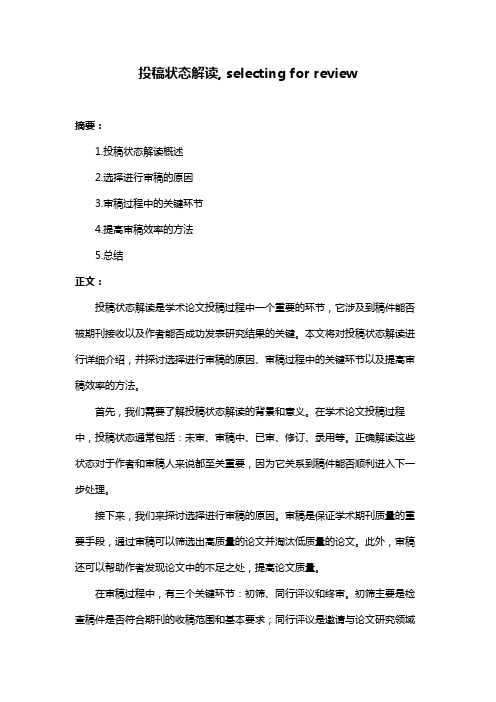
投稿状态解读, selecting for review
摘要:
1.投稿状态解读概述
2.选择进行审稿的原因
3.审稿过程中的关键环节
4.提高审稿效率的方法
5.总结
正文:
投稿状态解读是学术论文投稿过程中一个重要的环节,它涉及到稿件能否被期刊接收以及作者能否成功发表研究结果的关键。
本文将对投稿状态解读进行详细介绍,并探讨选择进行审稿的原因、审稿过程中的关键环节以及提高审稿效率的方法。
首先,我们需要了解投稿状态解读的背景和意义。
在学术论文投稿过程中,投稿状态通常包括:未审、审稿中、已审、修订、录用等。
正确解读这些状态对于作者和审稿人来说都至关重要,因为它关系到稿件能否顺利进入下一步处理。
接下来,我们来探讨选择进行审稿的原因。
审稿是保证学术期刊质量的重要手段,通过审稿可以筛选出高质量的论文并淘汰低质量的论文。
此外,审稿还可以帮助作者发现论文中的不足之处,提高论文质量。
在审稿过程中,有三个关键环节:初筛、同行评议和终审。
初筛主要是检查稿件是否符合期刊的收稿范围和基本要求;同行评议是邀请与论文研究领域
相关的专家对论文进行深入评价;终审是对论文进行最后的审核,确定是否录用。
如何提高审稿效率是每个学术期刊都需要关注的问题。
一种方法是优化审稿流程,减少不必要的环节,提高审稿速度。
另一种方法是利用现代技术手段,如在线审稿系统,实现审稿过程的自动化和智能化。
总之,投稿状态解读在学术论文投稿过程中具有重要意义。
通过了解审稿过程中的关键环节,我们可以更好地解读投稿状态,从而为作者和审稿人提供便利。
爱思唯尔投稿指南

▪ 作者会在相同的领域选择和其论文质量和研究 方法相匹配的期刊来投稿
▪ 从这一批期刊中,根据经验选择一本期刊
选择期刊时作者最看重的因素
2=
1
6
QUALITY
5
&
7
SPEED
8
4
2=
Data from 36,188 Authors; 0= unimportant 10= very important
▪ 编辑部日常管理
▪ 监督编辑部的工作效率
» 评审时间,对作者的及时响应
▪ 监督关键指标的变化
» copyflow, 订阅水平, 在线使用情况,质量指标(如:引用量,影响因 子),作者满意度
▪ 采取响应措施
» 编辑部成员更新(是否需要更换编辑?)
▪ 期刊生产和网络版
作者的需要
▪ 注册:记录他们的科研发现 ▪ 确定所有权和正确的存档
从网站选择期刊 1: SD
从网站选择期刊 2 : ELSEVIER
作者门户 Author GATEWAY
在线投稿EES (Elsevier Editorial System)
在线投稿1:注册
在线投稿2:登陆
在线投稿3:作者主页
在线投稿4 :跟踪稿件进程
充分利用作者支持服务
▪ 在线投稿 ▪ 跟踪稿件的状态 ▪ 个性化作者主页
▪ “黑暗时代”以后,在1580年,罗威·埃尔塞维尔
(Lowys Elzevir)在荷兰莱顿( Leiden)大学城 开始经营他的书店
126周年
Non Solus
▪ 作为一所大学出版社,公司刊印了所有古典传 统学科主要著作的再版
▪ 公司冒着财务与个人安危的风险,出版了大量 在其它国家被禁止的科学突破,如伽利略,笛卡儿,洛克的论文。
英文投稿过程中的十种状态解析
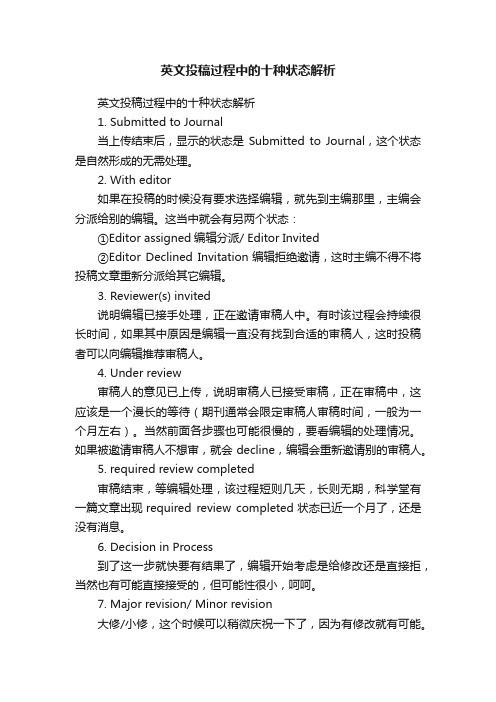
英文投稿过程中的十种状态解析英文投稿过程中的十种状态解析1. Submitted to Journal当上传结束后,显示的状态是Submitted to Journal,这个状态是自然形成的无需处理。
2. With editor如果在投稿的时候没有要求选择编辑,就先到主编那里,主编会分派给别的编辑。
这当中就会有另两个状态:①Editor assigned编辑分派/ Editor Invited②Editor Declined Invitation编辑拒绝邀请,这时主编不得不将投稿文章重新分派给其它编辑。
3. Reviewer(s) invited说明编辑已接手处理,正在邀请审稿人中。
有时该过程会持续很长时间,如果其中原因是编辑一直没有找到合适的审稿人,这时投稿者可以向编辑推荐审稿人。
4. Under review审稿人的意见已上传,说明审稿人已接受审稿,正在审稿中,这应该是一个漫长的等待(期刊通常会限定审稿人审稿时间,一般为一个月左右)。
当然前面各步骤也可能很慢的,要看编辑的处理情况。
如果被邀请审稿人不想审,就会decline,编辑会重新邀请别的审稿人。
5. required review completed审稿结束,等编辑处理,该过程短则几天,长则无期,科学堂有一篇文章出现required review completed状态已近一个月了,还是没有消息。
6. Decision in Process到了这一步就快要有结果了,编辑开始考虑是给修改还是直接拒,当然也有可能直接接受的,但可能性很小,呵呵。
7. Major revision/ Minor revision大修/小修,这个时候可以稍微庆祝一下了,因为有修改就有可能。
具体怎么改就不多说了,谦虚谨慎是不可少的(因为修改后一般会再发给审稿人看,所以一定要细心的回答每一个审稿人的每一个问题,态度要谦逊,要让审稿人觉得他提的每个问题都很有水准的,然后针对他的问题,一个一个的做出答复,能修改的就修改,不能修改的给出理由,而且都要列出来,文章的哪一段哪一行修改了最好都说出来,记住:给审稿人减少麻烦就是给你自己减少麻烦!另注:有时,审稿人会在修改意见里隐讳里说出要你仔细阅读某几篇文献,这时可要注意了,其中某些文章可能就是评审者自己发表的,这时你最好在你的修改稿中加以引用),修改后被拒绝的例子也多不胜数的。
SCI 期刊投稿各种状态显示对投稿者来说是非常重要的,本文主要介绍了不同状态投稿者需要注意的事项。
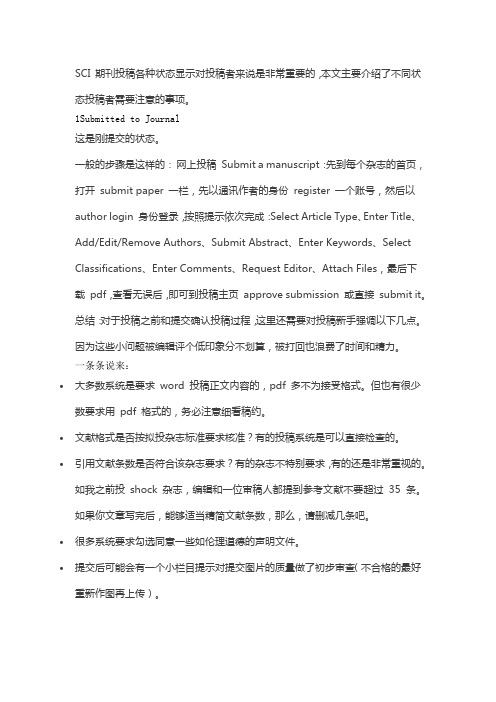
SCI 期刊投稿各种状态显示对投稿者来说是非常重要的,本文主要介绍了不同状态投稿者需要注意的事项。
1Submitted to Journal这是刚提交的状态。
一般的步骤是这样的:网上投稿Submit a manuscript:先到每个杂志的首页,打开submit paper 一栏,先以通讯作者的身份register 一个账号,然后以author login 身份登录,按照提示依次完成:Select Article Type、Enter Title、Add/Edit/Remove Authors、Submit Abstract、Enter Keywords、Select Classifications、Enter Comments、Request Editor、Attach Files,最后下载pdf,查看无误后,即可到投稿主页approve submission 或直接submit it。
总结:对于投稿之前和提交确认投稿过程,这里还需要对投稿新手强调以下几点。
因为这些小问题被编辑评个低印象分不划算,被打回也浪费了时间和精力。
一条条说来:•大多数系统是要求word 投稿正文内容的,pdf 多不为接受格式。
但也有很少数要求用pdf 格式的,务必注意细看稿约。
•文献格式是否按拟投杂志标准要求核准?有的投稿系统是可以直接检查的。
•引用文献条数是否符合该杂志要求?有的杂志不特别要求,有的还是非常重视的。
如我之前投shock 杂志,编辑和一位审稿人都提到参考文献不要超过35 条。
如果你文章写完后,能够适当精简文献条数,那么,请删减几条吧。
•很多系统要求勾选同意一些如伦理道德的声明文件。
•提交后可能会有一个小栏目提示对提交图片的质量做了初步审查(不合格的最好重新作图再上传)。
•绝大多数投稿完成后需要view submission 和最后确认(approve submission)。
view submission 就是要求你再整体看看投稿填写的这些资料信息+ cover letter + 正文+ 图片表格,所生成的pdf 全文是否满意、合格,也是你投稿完成前最后一次检查的机会了。
Elsevier期刊投稿状态以及回复信件模板

1.第一次投稿Cover letter:主要任务是介绍文章主要创新以及声明没有一稿多投Dear Editors:We would like to submit the enclosed manuscript entitled “Paper Title”, which we wish to be considered for publication in “Journal Name”. No conflict of interest exits in the submission of this manuscript, and manuscript is approved by all authors for publication. I would like to declare on behalf of my co-authors that the work described was original research that has not been published previously, and not under consideration for publication elsewhere, in whole or in part. All the authors listed have approved the manuscript that is enclosed.In this work, we evaluated ……(简要介绍一下论文的创新性). I hope this paper is suitable for “Journal Name”.The following is a list of possible reviewers for your consideration:1) Name A E-mail: ××××@××××2) Name B E-mail: ××××@××××We deeply appreciate your consideration of our manuscript, and we look forward to receiving comments from the reviewers. If you have any queries, please don’t hesitate to contact me at the address below.Thank you and best regards.Yours sincerely,××××××Corresponding author:Name: ×××E-mail: ××××@××××二、催稿信:询问稿件处理到声明步骤Dear Prof. ×××:Sorry for disturbing you. I am not sure if it is the right time to contact you to inquire about the status of my submitted manuscript titled “Paper Title”. (ID: 文章稿号), although the status of “With Editor”has been lasting for more than two months, since submitted to journal three months ago. I am just wondering that my manuscript has been sent to reviewers or not?I would be greatly appreciated if you could spend some of your time check the status for us. I am very pleased to hear from you on the reviewer’s comments.Thank you very much for your consideration.Best regards!Yours sincerely,××××××Corresponding author:Name: ×××E-mail: ××××@××××三、修改稿Cover letterDear Dr/ Prof..(写上负责你文章编辑的姓名,显得尊重,因为第一次的投稿不知道具体负责的编辑,只能用通用的Editors):On behalf of my co-authors, we thank you very much for giving us an opportunity to revise our manuscript, we appreciate editor and reviewers very much for their positive and constructive comments and suggestions on our manuscript entitled “Paper Title”. (ID: 文章稿号).We have studied reviewer’s comments carefully and have made revision which marked in red inthe paper. We have tried our best to revise our manuscript according to the comments. Attached please find the revised version, which we would like to submit for your kind consideration.We would like to express our great appreciation to you and reviewers for comments on our paper. Looking forward to hearing from you.Thank you and best regards.Yours sincerely,××××××Corresponding author:Name: ×××E-mail: ××××@××××四、修改稿回答审稿人的意见(最重要的部分)List of ResponsesDear Editors and Reviewers:Thank you for your letter and for the reviewers’comments concerning our manuscript entitled “Paper Title”(ID: 文章稿号). Those comments are all valuable and very helpful for revising and improving our paper, as well as the important guiding significance to our researches. We have studied comments carefully and have made correction which we hope meet with approval. Revised portion are marked in red in the paper. The main corrections in the paper and the responds to the reviewer’s comments are as flowing:Responds to the reviewer’s comments:Reviewer #1:1. Response to comment: (……简要列出意见……)Response: ××××××2. Response to comment: (……简要列出意见……)Response: ××××××。
Elsevier期刊投稿模板和投稿经验

General-Template[Title Page]Article TitleAuthorsAuthor affiliationsCorrespondence information: Corresponding author name,affiliation, detailed permanent address, email address,telephone number(Check the Guide for authors to see the required information onthe title page)Put the title of your abstract here using both upper and lower case letters, Times New Roman, 12?pts, bold, centered, doublespacedA.?Author a,B.?Author b,C.?Author a,*a Department, University, Street, Postal-Code City, Countryb Laboratory, Institute, Street, Postal-Code City, Country AbstractThis general template helps you on preparing manuscript for part of Elsevier Journals. Use this document as a template if you are using Microsoft Word 6.0 or later. Here comes self-contained abstract. Please read the Guide for Authors of your target journal for the requirements of Abstract. Pay special attention to the word count.PACS(optional, as per journal):Keywords:Keyword 1.D; Keyword 2.B (Read the Guide for Authors for the requirements for Keywords, including number, thesaurus, and classification indications)* Corresponding author. Tel.: +xx xxx xx xx; fax: +xx xxx xx xx.1. IntroductionThe manuscript should be prepared and submitted according to the Guide for Authors of your taget journal. . For your convenience, brief instructions on manuscript preparation are recorded below.Please DO consult a recent journal paper for style and conventions. You may find samples on ScienceDirect. You need to check your manuscript carefully before you submit it. The editor reserves the right to return manuscripts that do not conform to the instructions for manuscript preparation.2. General remarks on manuscript preparationGenerally, double line spacing, 12 pts font, and Times New Roman are preferred when you type the manuscript for review. This text formatting is provided in order to facilitate referee process and is also required for proper calculation of your manuscript length. Typing your manuscript follows the order: Title, Authors, Affiliations, Abstract, Keywords, Main text, Acknowledgements (optional), References (optional), Figure captions, Figures and Tables. Please consult the Guide for Authors for the proper organization of the main text. Ensure thateach new paragraph is clearly indicated. Some journals also require lines to be numbered throughout the manuscript. You will usually want to divide your article into numbered sections and subsections. Present figures and tables at the right places mentioned in the Guide for Authors.Most formatting codes are removed or replaced while processing your article so there is no need for you to use excessive layout styling. Please do not use options such as automatic word breaking, double columns or automatic paragraph numbering (especially for numbered references). Do use bold face, italic, subscripts, superscripts, etc., as appropriate.2.1 IllustrationsMany journals required that figures and tables to be presented on separate pages at the end of the manuscript. The preferable file formats are: EPS (for vector graphics) and TIF (for bitmaps). However, PDF and MS Office (Word, Excel, Powerpoint figures) files are also acceptable. Use file names that enable to identify their contents in terms of figure number and format (e.g. fig1.tif, fig2.eps, fig3.pdf). All artwork has to be numbered according to its sequence in the text. All of them should havecaptions. Colour figures in printed version require an extra fee for most journals. Generally, no vertical rules (lines) should be used in tables. Illustrations should not duplicate descriptions that appear elsewhere in the manuscript.Please look at for more detailed instructions on artwork preparations.2.2 EquationsConventionally, in mathematical equations variables and anything thatrepresents a value appear in italics. You are encouraged to use equation-editing tools such as mathtype to edit equations. Please make use of the numbering and referencing functions.2.3 CitationsThere are different styles of in-text citations and reference lists. DO consult the Guide for Authors to see the given examples. Pay special attention to the format of author names, journal names, publication year, volume and page span.AcknowledgementsThis section is optional.References[1].[2].Figure CaptionsFig.1 Put at this page the collected figure captions. The figure captions should be as brief as possible. It should also contain sufficient information that readers do not need to refer to the main text.Fig.2 Put here the figure caption of figure 2 (also the legend to figure 2).Fig. 3Fig.?1. Sample figure. Do not reduce or enlarge any images after placement in an MS Office application as this can lead to loss of image quality. While inserting vector graphics ensure that you use only truetype fonts. These should preferably be in one, or a combination, of the following fonts: Arial, Courier, Helvetica, Symbol, Times.Table?1Sample table: (使用三线表)Parameter Compound?1 Compound?2 a (?) 4.5832 4.9365Δ E a (eV) 1.745 1.592 ………………a This is an example of a table footnote.关于Elsevier旗下期刊投稿1 关于Elsevier旗下期刊投稿概述(1) Elsevier旗下共有1300多种期刊。
爱思唯尔稿件格式
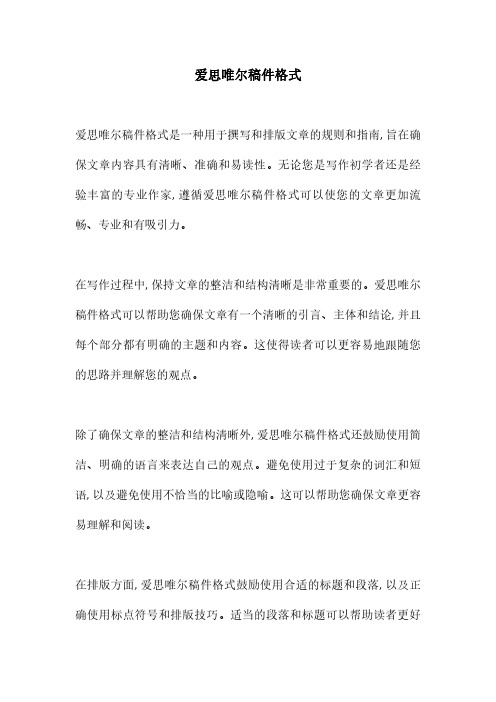
爱思唯尔稿件格式
爱思唯尔稿件格式是一种用于撰写和排版文章的规则和指南,旨在确保文章内容具有清晰、准确和易读性。
无论您是写作初学者还是经验丰富的专业作家,遵循爱思唯尔稿件格式可以使您的文章更加流畅、专业和有吸引力。
在写作过程中,保持文章的整洁和结构清晰是非常重要的。
爱思唯尔稿件格式可以帮助您确保文章有一个清晰的引言、主体和结论,并且每个部分都有明确的主题和内容。
这使得读者可以更容易地跟随您的思路并理解您的观点。
除了确保文章的整洁和结构清晰外,爱思唯尔稿件格式还鼓励使用简洁、明确的语言来表达自己的观点。
避免使用过于复杂的词汇和短语,以及避免使用不恰当的比喻或隐喻。
这可以帮助您确保文章更容易理解和阅读。
在排版方面,爱思唯尔稿件格式鼓励使用合适的标题和段落,以及正确使用标点符号和排版技巧。
适当的段落和标题可以帮助读者更好
地理解您的文章,以及确保文章的逻辑性和一致性。
正确使用标点符号可以帮助您清晰地划分不同的观点和论述,并使文章更加易于阅读。
最后,遵循爱思唯尔稿件格式还鼓励在文章中使用关键词和短语,以便读者更好地理解文章的主题和内容。
适当使用关键词和短语可以帮助您更准确地描述自己的观点和想法,并使文章更加相关和有用。
总结起来,遵循爱思唯尔稿件格式可以帮助您写出更加流畅、专业和易读性的文章。
这可以确保您在写作过程中不会出现网址、链接、广告、敏感词或不良信息等问题,从而使您的文章更具可读性和吸引力。
SCI论文投稿状态如何进行解析-英辑学术润色
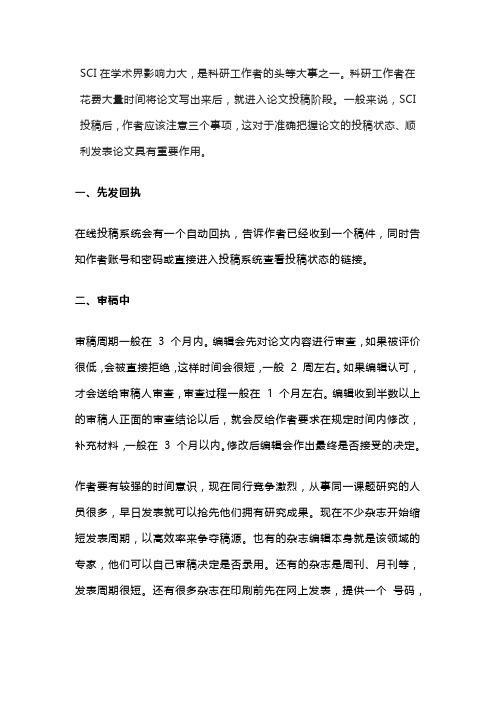
SCI在学术界影响力大,是科研工作者的头等大事之一。
科研工作者在花费大量时间将论文写出来后,就进入论文投稿阶段。
一般来说,SCI 投稿后,作者应该注意三个事项,这对于准确把握论文的投稿状态、顺利发表论文具有重要作用。
一、先发回执在线投稿系统会有一个自动回执,告诉作者已经收到一个稿件,同时告知作者账号和密码或直接进入投稿系统查看投稿状态的链接。
二、审稿中审稿周期一般在3 个月内。
编辑会先对论文内容进行审查,如果被评价很低,会被直接拒绝,这样时间会很短,一般 2 周左右。
如果编辑认可,才会送给审稿人审查,审查过程一般在 1 个月左右。
编辑收到半数以上的审稿人正面的审查结论以后,就会反给作者要求在规定时间内修改,补充材料,一般在3 个月以内。
修改后编辑会作出最终是否接受的决定。
作者要有较强的时间意识,现在同行竞争激烈,从事同一课题研究的人员很多,早日发表就可以抢先他们拥有研究成果。
现在不少杂志开始缩短发表周期,以高效率来争夺稿源。
也有的杂志编辑本身就是该领域的专家,他们可以自己审稿决定是否录用。
还有的杂志是周刊、月刊等,发表周期很短。
还有很多杂志在印刷前先在网上发表,提供一个号码,相当于正式发表后的页码,可以正式引用。
这些杂志往往能否较快发表,投稿时要注意选择。
三、审稿意见编辑部一般负责审查文字、处理审稿意见,审稿人负责对论文的创新性和正确性进行审查。
审稿意见有以下几种情况:①直接接受的很少见。
②少部分稿件接受,但需少量修改。
作者要按照编辑要求,逐个修改,并在回信中逐项说明,注明页、行。
③较多的稿件被要求修改后再审,作者要按照审稿意见作较大的修改,再次提交。
④退稿,随着稿件数量逐年增加,退稿率也逐渐增加。
一般来说,审稿意见还是非常专业和中肯的,论文作者在接收到审稿意见后,应该认真的阅读审稿意见并进行相应的修改。
除此之外,作者还需写一封回复信。
回复信怎么写呢?可以从以下三点出发。
首先,不论审稿人提了什么意见,你在回复的时候,第一句话一定要说:“谢谢您的建议,您的所有建议都非常的重要,它们对我的论文写作和科研工作都具有重要的指导意义!”其次,就是如何回答审稿人意见也要讲究一些方法技巧:1、不遗漏任何意见,不管是期刊编辑或是同行评审员提出的。
爱思唯尔新版投稿系统(EVISE)论文状态详解

爱思唯尔新版投稿系统(EVISE)论⽂状态详解What does the status of my submission mean in EVISE? Status DescriptionSubmission Initiated The Author has initiated a submis?ion, but has not yet completed it. This submis?ion and its status is only visible for the author.With Journal The submis?ion has been received by the journal, but has not yet been assigned to an Editor.No EditorInvitedAn Editor has not yet been invited to handle the submis?ion. Editor Invited An Editor has been invited to handle the submis? ion.With Editor The submis?ion has been assigned to an Editor.Reviewer Invited At least one Reviewer has been invited to review the submis?ion, but none have yet accepted to review. Under Review At least one Reviewer has accepted to review the submis?ion, however the required number of reviews for the submis?ion have not yet been received.Ready for Decision The required number of reviews for the submis?ion have been completed.Decision Pending The handling Editor has submitted a decision and the submis?ion is now pending the higher level Editor's decision.Decision in Progress The final Handling Editor in a journal with split decision and author notification tasks has submitted a decision but the Administrative Editor has not yet notified the author.Rejected The Editor has submitted a reject decision to the Author.Status DescriptionAccepted The Editor has submitted an accept decision to the Author, but the submis?ion has not yet been sent to Production. Sent toProductionThe accepted submis?ion has been sent to Production.Transmittal Failed The submis?ion has not reached Production although the send to Production task has been completed. Resubmis?ionRequestedThe submis?ion has been sent back to the Author.Under Resubmis?ion The Author has initiated a resubmis?ion, but has not yet completed it.Declined toResubmitThe Author has declined to resubmit their submis?ion.Revision Requested The Editor has submitted a revise decision to the Author, who has not yet agreed or declined to revise. Submit Revision The Author has initiated a revision, but has not yet completed it. This revision and its status is only visible for the author.Under Revision The Author has agreed to revise their submis?ion.Declined toReviseThe Author has declined to revise their submis?ion. Withdrawn The submis?ion has been withdrawn from the journal.In CopyEditingThe submis?ion has been assigned to a Copy Editor.Status DescriptionArticle Transfer Offered The Editor has submitted a reject and offer transfer decision to the Author, who has not yet accepted or declinedthe Article Transfer Service offer.Transferred The Author has accepted a transfer offer and the submis?ion has been transferred to another journal.Not Transferred The Author has declined a transfer offer and the submis?ion has not been transferred.。
在线投稿系统各种稿件状态大剖析---老鸟养成必读!
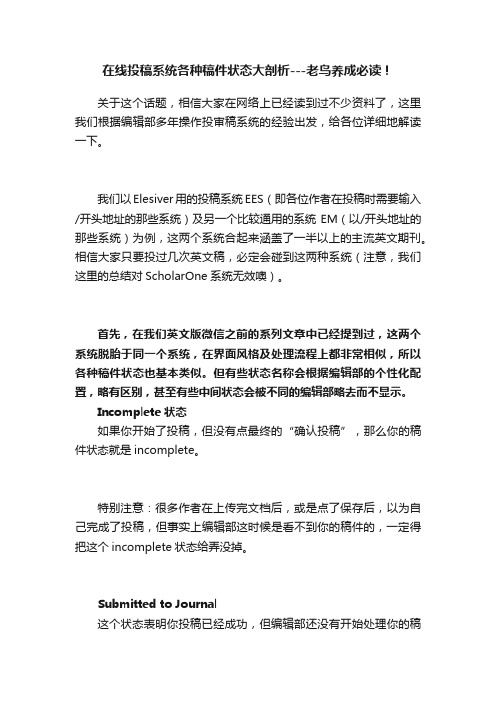
在线投稿系统各种稿件状态大剖析---老鸟养成必读!关于这个话题,相信大家在网络上已经读到过不少资料了,这里我们根据编辑部多年操作投审稿系统的经验出发,给各位详细地解读一下。
我们以Elesiver用的投稿系统EES(即各位作者在投稿时需要输入/开头地址的那些系统)及另一个比较通用的系统EM(以/开头地址的那些系统)为例,这两个系统合起来涵盖了一半以上的主流英文期刊。
相信大家只要投过几次英文稿,必定会碰到这两种系统(注意,我们这里的总结对ScholarOne系统无效噢)。
首先,在我们英文版微信之前的系列文章中已经提到过,这两个系统脱胎于同一个系统,在界面风格及处理流程上都非常相似,所以各种稿件状态也基本类似。
但有些状态名称会根据编辑部的个性化配置,略有区别,甚至有些中间状态会被不同的编辑部略去而不显示。
Incomplete状态如果你开始了投稿,但没有点最终的“确认投稿”,那么你的稿件状态就是incomplete。
特别注意:很多作者在上传完文档后,或是点了保存后,以为自己完成了投稿,但事实上编辑部这时候是看不到你的稿件的,一定得把这个incomplete状态给弄没掉。
Submitted to Journal这个状态表明你投稿已经成功,但编辑部还没有开始处理你的稿件,这段时间能做的只有等,当然这个状态持续时间太长,超过十天半月了,那么可以发邮件提醒一下编辑。
With Editor及可能出现的Technical Check in Process,Editor assigned, Editor Declined Invitation事实上稿件第一步先到达编辑部(投稿系统中有相应的编辑部账号)作初审,Elsevier很多刊采用Journal Manager初审制,代替编辑部的功能。
初审在系统中被称为Technical Check,如果初审到一半编辑停下工作,则会出现Technical Check in Process 这个中间状态(有些投稿系统选择不显示这个状态)。
投稿状态解读, selecting for review
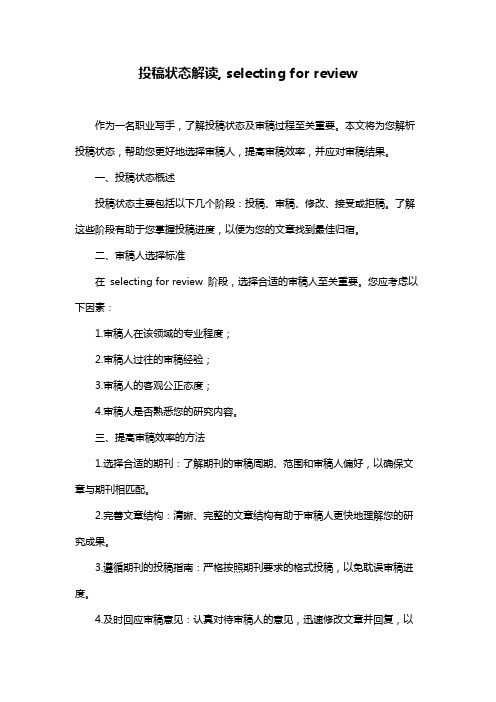
投稿状态解读, selecting for review作为一名职业写手,了解投稿状态及审稿过程至关重要。
本文将为您解析投稿状态,帮助您更好地选择审稿人,提高审稿效率,并应对审稿结果。
一、投稿状态概述投稿状态主要包括以下几个阶段:投稿、审稿、修改、接受或拒稿。
了解这些阶段有助于您掌握投稿进度,以便为您的文章找到最佳归宿。
二、审稿人选择标准在selecting for review 阶段,选择合适的审稿人至关重要。
您应考虑以下因素:1.审稿人在该领域的专业程度;2.审稿人过往的审稿经验;3.审稿人的客观公正态度;4.审稿人是否熟悉您的研究内容。
三、提高审稿效率的方法1.选择合适的期刊:了解期刊的审稿周期、范围和审稿人偏好,以确保文章与期刊相匹配。
2.完善文章结构:清晰、完整的文章结构有助于审稿人更快地理解您的研究成果。
3.遵循期刊的投稿指南:严格按照期刊要求的格式投稿,以免耽误审稿进度。
4.及时回应审稿意见:认真对待审稿人的意见,迅速修改文章并回复,以体现对审稿过程的尊重。
四、审稿过程中的沟通与技巧1.保持礼貌:在与审稿人和编辑沟通时,礼貌至关重要。
2.善于倾听:尊重审稿人的意见,即使您不同意,也要保持礼貌和谦逊。
3.主动沟通:在关键节点主动与审稿人或编辑沟通,了解审稿进度。
五、应对审稿结果的策略1.接受审稿结果:对于积极的审稿结果,要认真对待审稿人的意见,进行适当修改。
2.应对拒稿:分析拒稿原因,改进文章并重新投稿。
同时,保持积极的心态,不要因为一次拒稿而气馁。
通过以上策略,您将能更好地应对投稿状态及审稿过程,为您的文章找到最佳归宿。
论文投稿稿件状态
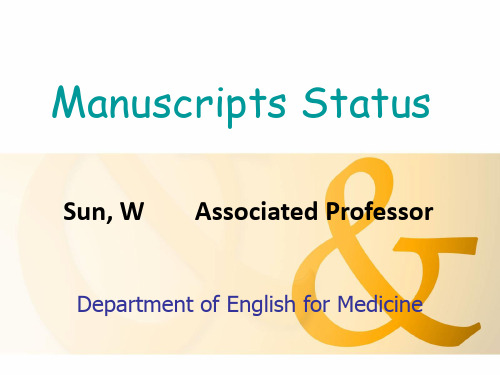
4. Under review 所花的时间
看来各个杂志的往上显示状态略有不同. 有的投稿后 STATUS 分别是"NEW MANUSCRIPT; EDITOR INVITED; WITH EDITOR; UNDER REVIEW; WITH REVIEWERS;" 等等.
2. 如何检查已投稿件的状态?
你可以用你的注册用户再次进入,选择 Author Centre(Center,见下图)查看当 前的Status(图),一般包括:
1.等待Editor分配(with editor) ; 2.等待Reviewers回应(under review) ; 3.回复。
3. 从“under review”到”with review”所花的时
The manuscript is pending a quality check by the staff or editor. This involves verifying that the MS PDF contains a complete manuscript (text, tables, figures, etc.) and is suitable for review purposes.
12. MS Rejected
A decision to decline publication has been made by the editor, and a rejection letter has been sent to the author.
Elsevier投稿的一些问题
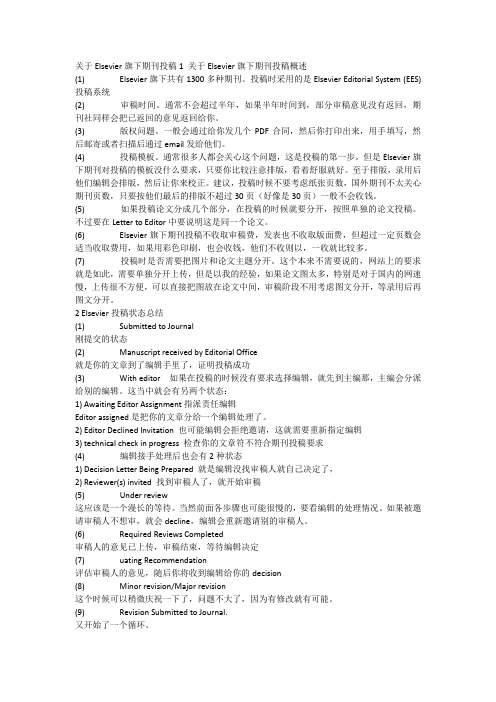
关于Elsevier旗下期刊投稿1 关于Elsevier旗下期刊投稿概述(1) Elsevier旗下共有1300多种期刊。
投稿时采用的是Elsevier Editorial System (EES)投稿系统(2) 审稿时间。
通常不会超过半年,如果半年时间到,部分审稿意见没有返回,期刊社同样会把已返回的意见返回给你。
(3) 版权问题。
一般会通过给你发几个PDF合同,然后你打印出来,用手填写,然后邮寄或者扫描后通过email发给他们。
(4) 投稿模板。
通常很多人都会关心这个问题,这是投稿的第一步。
但是Elsevier旗下期刊对投稿的模板没什么要求,只要你比较注意排版,看着舒服就好。
至于排版,录用后他们编辑会排版,然后让你来校正。
建议,投稿时候不要考虑纸张页数,国外期刊不太关心期刊页数,只要按他们最后的排版不超过30页(好像是30页)一般不会收钱。
(5) 如果投稿论文分成几个部分,在投稿的时候就要分开,按照单独的论文投稿。
不过要在Letter to Editor中要说明这是同一个论文。
(6) Elsevier旗下期刊投稿不收取审稿费,发表也不收取版面费,但超过一定页数会适当收取费用,如果用彩色印刷,也会收钱,他们不收则以,一收就比较多。
(7) 投稿时是否需要把图片和论文主题分开。
这个本来不需要说的,网站上的要求就是如此,需要单独分开上传,但是以我的经验,如果论文图太多,特别是对于国内的网速慢,上传很不方便,可以直接把图放在论文中间,审稿阶段不用考虑图文分开,等录用后再图文分开。
2 Elsevier投稿状态总结(1) Submitted to Journal刚提交的状态(2) Manuscript received by Editorial Office就是你的文章到了编辑手里了,证明投稿成功(3) With editor如果在投稿的时候没有要求选择编辑,就先到主编那,主编会分派给别的编辑。
这当中就会有另两个状态:1) Awaiting Editor Assignment指派责任编辑Editor assigned是把你的文章分给一个编辑处理了。
- 1、下载文档前请自行甄别文档内容的完整性,平台不提供额外的编辑、内容补充、找答案等附加服务。
- 2、"仅部分预览"的文档,不可在线预览部分如存在完整性等问题,可反馈申请退款(可完整预览的文档不适用该条件!)。
- 3、如文档侵犯您的权益,请联系客服反馈,我们会尽快为您处理(人工客服工作时间:9:00-18:30)。
What does the status of my submission mean in EVISE? Status Description
Submission Initiated The Author has initiated a submisѕion, but has not yet completed it. This submisѕion and its status is only visible for the author.
With Journal The submisѕion has been received by the journal, but has not yet been assigned to an Editor.
No Editor Invited An Editor has not yet been invited to handle the submisѕion.
Editor
Invited
An Editor has been invited to handle the submisѕion. With Editor The submisѕion has been assigned to an Editor.
Reviewer Invited At least one Reviewer has been invited to review the submisѕion, but none have yet accepted to review.
Under Review At least one Reviewer has accepted to review the submisѕion, however the required number of reviews for the submisѕion have not yet been received.
Ready for Decision The required number of reviews for the submisѕion have been completed.
Status Description
Decision Pending The handling Editor has submitted a decision and the submisѕion is now pending the higher level Editor's decision.
Decision in Progress The final Handling Editor in a journal with split decision and author notification tasks has submitted a decision but the Administrative Editor has not yet notified the author.
Rejected The Editor has submitted a reject decision to the Author.
Accepted The Editor has submitted an accept decision to the Author, but the submisѕion has not yet been sent to Production.
Sent to
Production
The accepted submisѕion has been sent to Production.
Transmittal Failed The submisѕion has not reached Production although the send to Production task has been completed.
Resubmisѕion
Requested
The submisѕion has been sent back to the Author.
Under Resubmisѕion The Author has initiated a resubmisѕion, but has not yet completed it.
Declined to
Resubmit
The Author has declined to resubmit their submisѕion.
Status Description
Revision Requested The Editor has submitted a revise decision to the Author, who has not yet agreed or declined to revise.
Submit Revision The Author has initiated a revision, but has not yet completed it. This revision and its status is only visible for the author.
Under
Revision
The Author has agreed to revise their submisѕion.
Declined to
Revise
The Author has declined to revise their submisѕion. Withdrawn The submisѕion has been withdrawn from the journal.
In Copy
Editing
The submisѕion has been assigned to a Copy Editor.
Article Transfer Offered The Editor has submitted a reject and offer transfer decision to the Author, who has not yet accepted or declined the Article Transfer Service offer.
Transferred The Author has accepted a transfer offer and the submisѕion has been transferred to another journal.
Not Transferred The Author has declined a transfer offer and the submisѕion has not been transferred.
如有侵权请联系告知删除,感谢你们的配合!。
